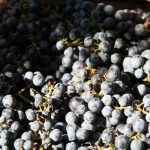So, we know and it’s well established that Plavac Mali (“the little Plavac”) is probably the best known and appreciated indigenous Croatian red wine variety (if you disagree with this statement, please continue reading this anyway). The name comes from the fact that the berries on the Plavac Mali grape are quite small and packed. So, yeah, quite an obvious question poses itself: is there such a thing as “Plavac Veliki” (“the big Plavac”)? The answer is, and you guessed it, I’m sure: yes and no.
Let me explain: there are several wine varieties that are erroneously called “Plavac Veliki” (or Veli, which is synonymous). Maletić and co-authors in their Green Book of Indigenous Grapevine Varieties of Croatia mention Plavac Veli(ki) four times, related to four different varieties. One of those varieties mentioned in the book is Plavac, accentuated differently in Croatian than you would usually pronounce the varietal name, is an almost completely forgotten indigenous variety from the northern island of Krk, often was referred to as Plavac Veli. These days it’s almost non-existent because of the low quality of wine it gives, and it has absolutely no relation to the star of this article, Plavac Mali.
The other three varieties are south-dalmatian, as is Plavac Mali; two of those are said to be erroneously called Plavac Veliki: Dobričić, which we know quite well as one of the parents of Plavac Mali and a very local variety of Kaštela called Ljutun, a variety that was never too relevant for winemaking and has (as far as we know) no relation to Plavac Mali, except for the fact that sometimes it was called Plavac Veliki by mistake (and that mistake is even listed in the “Nacionalna lista priznatih kultivara vinove loze”, a official document by the Ministry of Agriculture listing all the known cultivars in Croatia).
The fourth variety nicknamed Soić is probably the one that is most closely related to Plavac Mali, and probably has the strongest claim to the name. It has other names as well, the authors mention Glavinuša in that book, and Glavinuša is also a name used for another variety: the one that is, in fact, a direct descendant of Plavac Mali! Anyway, Soić is a quite rare variety, some sources say that it’s just one of many clones of Plavac Mali, of much lower quality, larger berries and higher acids, but almost unusable for vinification, except in blends where the acids from Soić are needed to make a better wine. So, when you see that Plavac Veliki (although, that will be quite a rare occasion as well) is listed as a variety in a blend, it probably stands for Soić!
There are other varieties with similar names, sounding similar to Plavac Mali:
- Plavac Mali Sivi (Plavac Mali the grey, not related to Gandalf) is a mutant of the Plavac Mali grape that just isn’t dark enough – it’s brightly pink or “grey”, and produces white wines. It has not been around for long, it was first noticed in the sixties and then forgotten, but recently found again and some research has been done on it, as well as some vineyards on Korčula planted with Plavac Mali that gives white wines. The results are not spectacular, but let’s give it some more time,
- Plavac Runjavac, a very old variety, related to Plavac Mali, an exceptionally sour grape (that much so that the ancient story goes that even the birds wouldn’t eat it, even at the peak ripeness) that is almost completely lost and has not been used to make wine since the early 20th century,
- Plavec Žuti, a white wine variety from the central Croatia, in the region near the Slovenian border which used to be considered a variety that came from Moldavia, but that claim has since been disproven. This last variety has absolutely nothing to do with Dalmatian Plavac Mali, obviously.
Tomić winery on Hvar is one of the rare wineries acknowledging that their Plavac wine is a blend of Plavac Mali, Plavac Veliki and Darnekuša. I asked them what exactly they mean when they say “Plavac Veliki”, and Silvana Sanseović told me that what they mean is a mutant, similar to Plavac Mali Sivi mentioned before, the result of the clone selection in which the clones with larger berries are selected and used for future production. She mentions other similar mutations, such as the sweet one, early one etc, and says that they have some of the “Plavac Mali Veliki” in their vineyards.
So, no, there’s no such thing as “Plavac Veliki”. There is, however, a chance that you might hear someone usiAcng that phrase to describe grapes or wines, and in those situations they might be referring to either the old variety of Soić, almost lost and forgotten in Dalmatia, or the Plavac Mali Veliki clone – Plavac Mali mutant that was selected just because it had somewhat larger berries.
PS: Wikipedia says that sometimes Zinfandel, or as we call it Tribidrag can also be called “Plavac Veliki”. I was not able to find any Croatian source that would confirm this statement.











